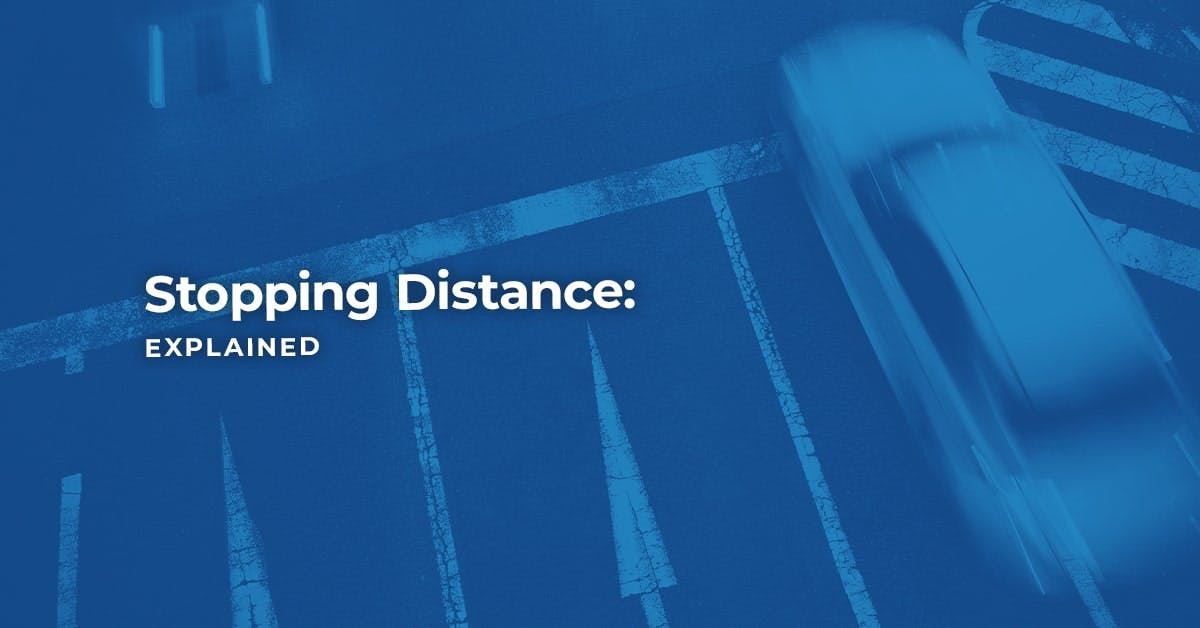When you understand stopping distance, you will have a better view of the road ahead, improve your vehicle’s fuel economy, and be able to react quicker in the event of an emergency.
Read on and find out what stopping distance means, how much stopping distance you should leave, and how to know if you are leaving enough room.
Page Contents
- What Is Stopping Distance?
- How Much Stopping Distance Should I Leave?
- What Is the 2-Second Rule?
- What Will Affect Your Vehicle's Stopping Distance?
- What Is Thinking Distance?
- Which Factors Can Affect Thinking Distance?
- What Is Braking Distance?
- Which Factors Can Affect Braking Distance?
- How Much Can Stopping Distance Increase in Icy Weather?
- How Does Heavy Rain Affect Stopping Distance?
What Is Stopping Distance?
Stopping distance = thinking distance + braking distance.
In other words, stopping distance is the time it takes to bring a moving vehicle to a complete stop.
This time includes the time it takes to react to the hazard – thinking time - and the time it takes for the brakes to stop the car – braking distance.
You should always leave enough distance in front of your vehicle so that it can come to a stop if traffic slows down suddenly, and so as to avoid tailgating.
Stopping distances can vary depending on factors like the weather conditions and the speed you are travelling at.
Remember, stopping distance will increase the faster you drive, and the wetter the road is - so it's important that you take extra care when driving in rain or snow.
If you've noticed any issues with your brakes, such as a soft brake pedal, it's really important that you have the problem fixed - especially if you're going to be driving in wet weather.
How Much Stopping Distance Should I Leave?
The following information about stopping differences at different speeds is based on information provided by the Highway Code.
20 mph
Thinking distance + braking distance = 6m + 6m
Stopping distance = 12m (40 feet)
30 mph
Thinking distance + braking distance = 9m + 14m
Stopping distance = 23m (75 feet)
40 mph
Thinking distance + braking distance = 12m + 24m
Stopping distance = 36m (120 feet)
50 mph
Thinking distance + braking distance = 15m + 38m
Stopping distance = 53m (175 feet)
60 mph
Thinking distance + braking distance = 18m + 55m
Stopping distance = 73m (240 feet)
70 mph
Thinking distance + braking distance = 21m + 75m
Stopping distance = 96m (315 feet)
The above information is an estimate which takes average car lengths into account and assumes that the road surface was dry.
The stopping distance at 20mph - for example - is approximately 3 car lengths.
What Is the 2-Second Rule?
If you want to make sure that you leave enough stopping distance, you can follow the 2-second rule:
- Pick a fixed point on the road ahead
- Watch when the car in front passes this point
- Leave at least 2 seconds before passing this point
By following the 2-second rule, you will be more likely to keep a safe distance.
However, if you are driving in wet weather, you should allow 4 seconds before passing the fixed point.
What Will Affect Your Vehicle's Stopping Distance?
Any of the following factors could affect your vehicle's stopping distance:
- The mass of the car
- Your speed
- The condition of your brakes
- Tyre pressure
- Tyre wear
- Tyre quality
- Road visibility
- The road's surface
- Any road spillages
What Is Thinking Distance?
Thinking distance is the distance that your vehicle travels between you noticing a hazard and braking.
It takes time to process what is happening before you start to brake.
According to the Highway Code – which bases its thinking distances on a thinking time of under 0.7 seconds – the thinking distance at 50mph is 15m.
Which Factors Can Affect Thinking Distance?
Other than your speed, there are other factors that can impact your reaction time to be aware of, including:
- If you have taken drugs or consumed alcohol
- If you are distracted
- If you are overly tired
The slower your reaction, the more likely it is that the distance covered before you react to danger on the road will increase.
Try to avoid driving when you are tired, and never drive under the influence.
Put your phone on silent and in a safe place before you set off, and put on a playlist you know and love so you don’t have to fiddle with the radio as you drive.
What Is Braking Distance?
Braking distance is the distance your car travels once you have hit the brakes, before it comes to a complete stop.
The Highway Code gives typical braking distances for a range of speeds, with the braking distance at 50mph being 38m.
At 70mph, the braking distance is a whopping 75m.
Which Factors Can Affect Braking Distance?
Whilst anti-lock brakes (ABS) won’t drastically reduce braking distance, they do make it easier to stay in control and steer whilst braking.
The condition of your car’s tyres, brakes, and suspension can increase braking distances.
Make sure that your tyres are properly inflated and have sufficient tread.
You should also ensure that your brakes are working well, and that your car’s suspension is not worn out.
You may wish to invest in a car service if you suspect that any of these components are not working as effectively as possible.
The heavier your vehicle is, the more the braking distance will increase.
Why not have a clean and clear out to make sure you only keep the essentials in your car?
How Much Can Stopping Distance Increase in Icy Weather?
Did you know that stopping distances can be as much as 10 times longer on icy roads?
As braking distance can increase when you drive in wet or icy weather too, you should always at least double the gap between your car and the one in front.
In winter, you should use winter tyres to ensure that your tyre's grip the road's surface effectively.
Even with winter tyres equipped, you still need to leave enough room between your car and the one in front and reduce your speed significantly.
How Does Heavy Rain Affect Stopping Distance?
In heavy rain, surface water may pool on the road's surface, reducing the grip your tyres have on the road and at least doubling the stopping distance.








No comments yet
Leave a comment